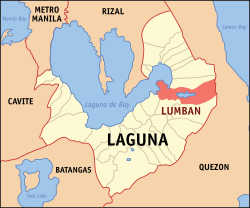Lumban | |
|---|---|
| Municipality of Lumban | |
 Rice fields of Lumban | |
| Nickname: | |
 Map of Laguna with Lumban highlighted | |
Location within the Philippines | |
| Coordinates: 14°17′49″N 121°27′32″E / 14.297°N 121.459°E | |
| Country | Philippines |
| Region | Calabarzon |
| Province | Laguna |
| District | 4th district |
| Founded | September 22, 1578 |
| Barangays | 16 (see Barangays) |
| Government | |
| • Type | Sangguniang Bayan |
| • mayor of Lumban[*] | Rolando G. Ubatay |
| • Vice Mayor | Belen B. Raga |
| • Representative | Maria Jamina Katherine B. Agarao |
| • Municipal Council | Members |
| • Electorate | 23,404 voters (2022) |
| Area | |
• Total | 40.53 km2 (15.65 sq mi) |
| Highest elevation | 724 m (2,375 ft) |
| Lowest elevation | 0 m (0 ft) |
| Population (2020 census)[5] | |
• Total | 32,330 |
| • Density | 800/km2 (2,100/sq mi) |
| • Households | 8,535 |
| Economy | |
| • Income class | 3rd municipal income class |
| • Poverty incidence | 8.97 |
| • Revenue | ₱ 136 million (2020) |
| • Assets | ₱ 171 million (2020) |
| • Expenditure | ₱ 130.7 million (2020) |
| • Liabilities | ₱ 66.95 million (2020) |
| Service provider | |
| • Electricity | First Laguna Electric Cooperative (FLECO) |
| Time zone | UTC+8 (PST) |
| ZIP code | 4014 |
| PSGC | |
| IDD : area code | +63 (0)49 |
| Native languages | Tagalog |
Lumban, officially the Municipality of Lumban (Tagalog: Bayan ng Lumban), is a 3rd class municipality in the province of Laguna, Philippines. According to the 2020 census, it has a population of 32,330 people.[5]
Lumban, one of Laguna's oldest towns, is located 7 kilometres (4.3 mi) from Santa Cruz, 94 kilometres (58 mi) southeast of Manila, and 55 kilometres (34 mi) north of Lucena. It got its name from Aleurites moluccanus, a tree locally named "lumbang".[7] The province's capital town, Santa Cruz, as well as Cavinti and Pagsanjan, were once part of Lumban. The town contains the river wherein the Laguna Copperplate Inscription was found. The copperplate is the oldest known document found in the Philippines, dating to 900AD.

Lumban is the home of Lake Caliraya, a man-made lake often visited by nature lovers and sportspeople. It is known as the "Embroidery Capital of the Philippines".[2] Fine Jusi and Piña cloth are embroidered by hand, and the finished product is worn by males as barong tagalog and by females as Saya (Filipiñana). These are export-quality items. Lumban is also known for its many designs of shoes, sandals, slippers, and step-ins - all made from local materials. They are usually sold in shopping malls in Metro Manila, albeit at slightly higher prices than what can be found in Laguna.[citation needed]
- ^ Department of Tourism - The Philippine's Ultimate Travel Guide for Tourist
- ^ a b Provincial Government of Laguna
- ^ Municipality of Lumban | (DILG)
- ^ "2015 Census of Population, Report No. 3 – Population, Land Area, and Population Density" (PDF). Philippine Statistics Authority. Quezon City, Philippines. August 2016. ISSN 0117-1453. Archived (PDF) from the original on May 25, 2021. Retrieved July 16, 2021.
- ^ a b Census of Population (2020). "Region IV-A (Calabarzon)". Total Population by Province, City, Municipality and Barangay. Philippine Statistics Authority. Retrieved 8 July 2021.
- ^ "PSA Releases the 2021 City and Municipal Level Poverty Estimates". Philippine Statistics Authority. 2 April 2024. Retrieved 28 April 2024.
- ^ Philippine Native Trees 101: Up Close and Personal. Green Convergence for Safe Food, Healthy Environment and Sustainable Economy (Organization), Hortica Filipina Foundation, Inc, Binhi Project (Philippines). 2012. pp. 307 pages. ISBN 9789719546900.



